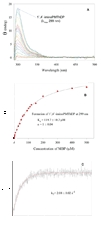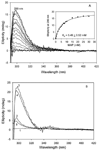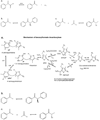Snapshot of a reaction intermediate: analysis of benzoylformate decarboxylase in complex with a benzoylphosphonate inhibitor
- PMID: 19320438
- PMCID: PMC2730839
- DOI: 10.1021/bi801950k
Snapshot of a reaction intermediate: analysis of benzoylformate decarboxylase in complex with a benzoylphosphonate inhibitor
Abstract
Benzoylformate decarboxylase (BFDC) is a thiamin diphosphate- (ThDP-) dependent enzyme acting on aromatic substrates. In addition to its metabolic role in the mandelate pathway, BFDC shows broad substrate specificity coupled with tight stereo control in the carbon-carbon bond-forming reverse reaction, making it a useful biocatalyst for the production of chiral alpha-hydroxy ketones. The reaction of methyl benzoylphosphonate (MBP), an analogue of the natural substrate benzoylformate, with BFDC results in the formation of a stable analogue (C2alpha-phosphonomandelyl-ThDP) of the covalent ThDP-substrate adduct C2alpha-mandelyl-ThDP. Formation of the stable adduct is confirmed both by formation of a circular dichroism band characteristic of the 1',4'-iminopyrimidine tautomeric form of ThDP (commonly observed when ThDP forms tetrahedral complexes with its substrates) and by high-resolution mass spectrometry of the reaction mixture. In addition, the structure of BFDC with the MBP inhibitor was solved by X-ray crystallography to a spatial resolution of 1.37 A (PDB ID 3FSJ). The electron density clearly shows formation of a tetrahedral adduct between the C2 atom of ThDP and the carbonyl carbon atom of the MBP. This adduct resembles the intermediate from the penultimate step of the carboligation reaction between benzaldehyde and acetaldehyde. The combination of real-time kinetic information via stopped-flow circular dichroism with steady-state data from equilibrium circular dichroism measurements and X-ray crystallography reveals details of the first step of the reaction catalyzed by BFDC. The MBP-ThDP adduct on BFDC is compared to the recently solved structure of the same adduct on benzaldehyde lyase, another ThDP-dependent enzyme capable of catalyzing aldehyde condensation with high stereospecificity.
Figures












References
-
- Bugg TDH. The development of mechanistic enzymology in the 20th century. Nat. Prod. Rep. 2001;18:465–493. - PubMed
-
- Kraut DA, Carroll KS, Herschlag D. Challenges in enzyme mechanism and energetics. Ann. Rev. Biochem. 2003;72:517–571. - PubMed
-
- Garcia-Viloca M, Gao J, Karplus M, Truhlar DG. How enzymes work: Analysis by modern rate theory and computer simulations. Science. 2004;303:186–195. - PubMed
-
- Zhang XY, Houk KN. Why enzymes are proficient catalysts: Beyond the Pauling paradigm. Acc. Chem. Res. 2005;38:379–385. - PubMed
-
- Naismith JH. Inferring the chemical mechanism from structures of enzymes. Chem. Soc. Rev. 2006;35:763–770. - PubMed
Publication types
MeSH terms
Substances
Associated data
- Actions
Grants and funding
LinkOut - more resources
Full Text Sources
Miscellaneous

